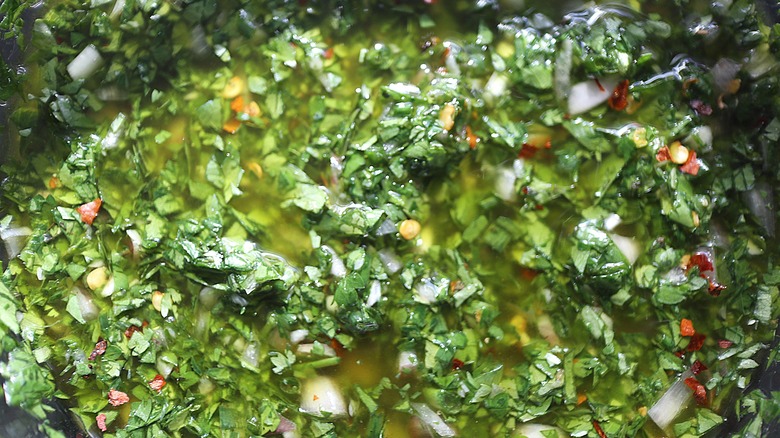Fresh Chimichurri Sauce Recipe
Chimichurri is quite the trendy condiment at present, but what is it and where does it come from? Eat Flavorly explains that this herb-based sauce is native to both Argentina and Uruguay, and while there are numerous variations on the recipe, all chimichurris tend to have a few ingredients in common: garlic, parsley, chiles, olive oil, and vinegar. The other ingredients added determine whether the chimichurri is a red or a green one.
This chimichurri recipe, which comes from recipe developer Cecilia Ryu, is a green one that Ryu says could be called "a type of pesto," although she adds that "chimichurri has vinegar for a slight tang [while] pesto does not." Ryu adds cilantro, oregano, and chives to her chimichurri mixture, but admits that the chives really aren't traditional. She says she just adds them because she loves their flavor, but says you can leave these out if you'd rather not use them. "The beauty of this sauce," she says, "is that it can be easily made with a combination of any leftover herbs you have at home."
Assemble the ingredients for fresh chimichurri sauce
Ryu's chimichurri begins with a base of red wine vinegar and lemon juice. She then adds a chopped shallot and some garlic as well as a whole lot of greenery: parsley, cilantro, fresh oregano, and chives. The sauce also includes olive oil, and you'll need some crushed red pepper, salt, and black pepper for seasoning.
Ryu tells us that it's okay to use a teaspoon of dried oregano in place of the fresh stuff, but adds that "all other herbs must be fresh."
Prep the herbs and aromatics
With such a produce-heavy sauce, there's naturally going to be a bit of prep work involved. You'll need to juice a lemon, and you'll also need to peel and chop the garlic and the shallot. (Luckily neither of these is as hard on the eyes as an onion!) Once this is done, you can take a knife or some scissors and chop or snip the parsley, cilantro, oregano, and chives.
Mix the ingredients for the chimichurri
Mix the lemon juice, vinegar, chopped herbs, garlic, and shallot together with the red pepper. Once this is done, whisk in the olive oil. As a final step, season the chimichurri with salt and pepper. The amounts Ryu lists for these ingredients are just suggestions — she says you may add more of either of these if you like, but you can also add less if that's your preference.
Allow the flavors to blend
After you've mixed up the chimichurri, don't use it right away. Instead, Ryu advises letting it sit for at least 20 minutes, telling us that this rest period will "release the flavors of the herbs." If you're not planning to use the sauce right away, you may store it in the fridge, but it will taste better if you take the time to bring it back to room temperature before serving. Ryu says, "I always serve chimichurri with skirt steak or roasted chicken," but adds that it can be served as a sauce for other types of meats and sausages and also as a topping for roast potatoes. You can also use chimichurri as a marinade for meat before you cook it.
Fresh Chimichurri Sauce Recipe
This fresh chimichurri sauce is loaded with green herbs and plenty of flavor — use it to marinate meat or as a dipping sauce.

Ingredients
- ½ cup red wine vinegar
- juice of 1 lemon
- 1 small shallot, minced
- 5 cloves garlic, minced
- ¾ cup chopped parsley
- ½ cup chopped cilantro
- 1 tablespoon chopped fresh oregano
- 2 tablespoons chopped chives
- ½ teaspoon crushed red pepper
- ¾ cup extra virgin olive oil
- 2 teaspoons salt
- ½ teaspoon black pepper
Directions
- Combine the vinegar, lemon juice, shallot, garlic, parsley, cilantro, oregano, chives, and red pepper together in a bowl.
- Whisk the olive oil into the other ingredients.
- Season the chimichurri with salt and pepper, and feel free to add more or less to taste.
- Let the chimichurri stand at room temperature for 20 minutes.
- Refrigerate if not used immediately, but allow the mixture to come to room temperature before serving.
Nutrition
| Calories per Serving | 260 |
| Total Fat | 27.2 g |
| Saturated Fat | 3.8 g |
| Trans Fat | 0.0 g |
| Cholesterol | 0.0 mg |
| Total Carbohydrates | 4.1 g |
| Dietary Fiber | 1.2 g |
| Total Sugars | 0.9 g |
| Sodium | 177.8 mg |
| Protein | 0.8 g |





